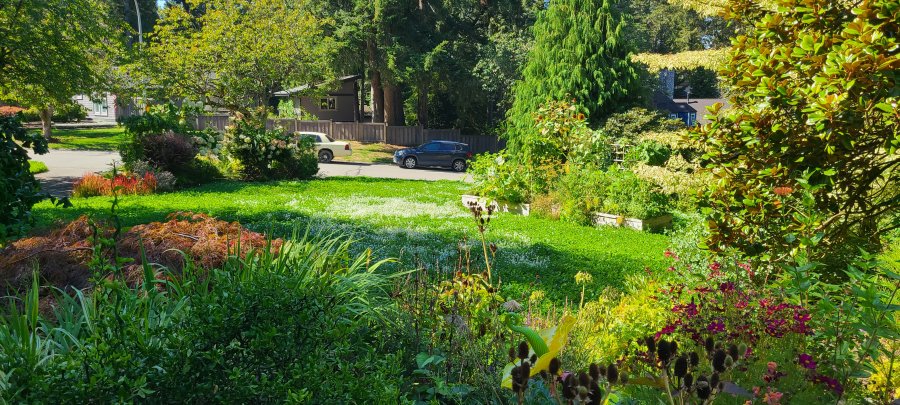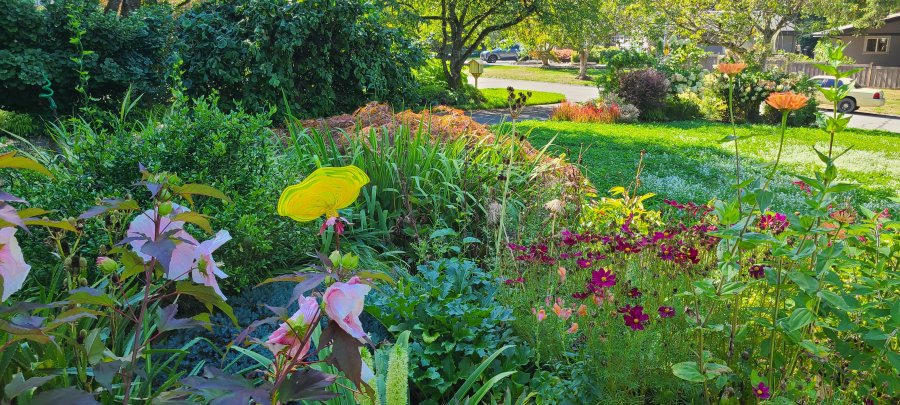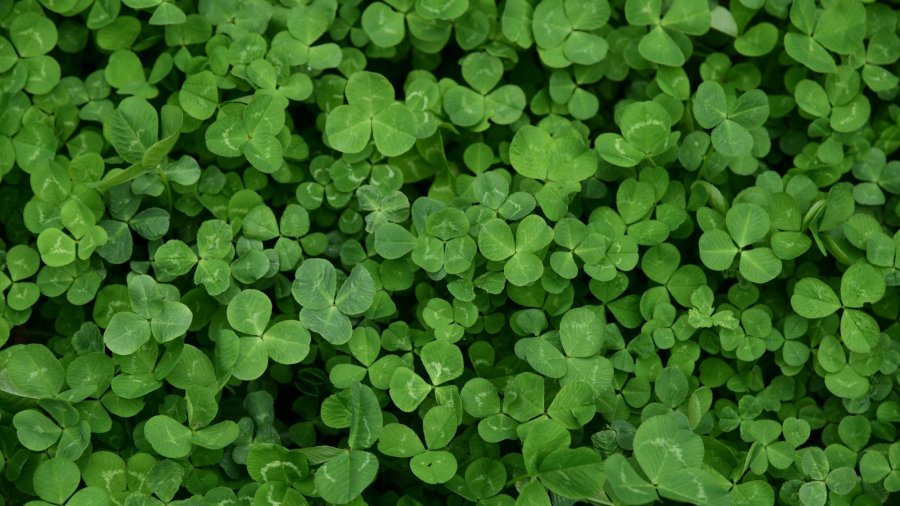Water-Wise Lawns and Gardens
Learn about ways to maintain a beautiful, sustainable yard in a way that conserves water.
Show us your natural lawn alternative!
Photo contest
We're running a contest from May 1 to August 31 to promote and encourage residents to switch from grass to water-wise lawns which use less water.
Alternative lawns can include microclover, bee turf, rocks with native plants and more.
Enter to win one of three $100 gift cards:
- Each submission must include a title of the photo and the property address.
- We will not be posting the property address.
- Read contest details.
Submit your photo to Waterwiselawn@surrey.ca
Benefits of water-wise lawns and gardens

Conserves water
By using drought-tolerant plants, water-wise gardens may use up to 50% less water than traditional lawn-based gardens. As we see more and more drought conditions from climate change, reliable water supply may become more challenging over time.
How much water you can save
Determining the precise amount of water savings can be challenging. The amount you save depends on your current watering practices, the type of lawn and plants you have, and the specific conditions of your site.
As a general guideline, water wise garden with lawn alternative may only require approximately ½ to ¾ inch of water every other weeks or even less to develop strong roots. After roots are developed, no or minimum watering is required.
Saves money
By reducing your water consumption, you'll also see savings on your water bill, making water-wise gardening not only environmentally friendly but also cost-effective.
The gardens also tend to adapt to adverse weather conditions and resist pests and diseases so you don’t need to spend money on replanting.
Low maintenance
Many drought-tolerant plants require less maintenance compared to traditional garden plants, saving you time and effort in the long run.
Promotes biodiversity
Water-wise gardens attract a variety of local wildlife, including birds, butterflies, and beneficial insects, creating a thriving ecosystem in your yard. Learn about Surrey’s biodiversity conservation goals.
Cool ground cover
Water-wise plants keep the ground cool, improve soil permeability, and aid in regulating the water cycle.
Grass lawn alternatives
Rock garden
Rock gardens are low-maintenance and require minimal watering, making them a water-wise alternative to grass lawns.
Designing a rock garden
Rock gardens use a mix of stones, gravel, and drought-tolerant plants like sedum and thyme. They improve drainage and work well in sunny or sloped areas where grass may not thrive.
Low maintenance
Once established, rock gardens need little watering or weeding. Landscape fabric under gravel helps control weeds, and plant choices support biodiversity.
Clover
Clover is lower-maintenance and less watering needs compared to common grass.
Combining clover and turf
Clover may be sown directly onto an existing turf lawn.
Combining grass and clover creates a more diverse and resilient lawn. Clover fixes nitrogen in the soil, benefiting both itself and the surrounding grass. Nitrogen is essential for healthy plant growth. Clover also typically stays green in drought conditions keeping your lawn greener while the grass turns golden.
Reseeding clover
Clover requires reseeding every few years. However, if the clover is mixed with other grasses, like mixed lawn seed, it may reseed itself, so typically no or minimal reseeding is required.
Note: Blooming clover attracts bees and other pollinators, which is essential to food web and encourage biodiversity. If you have children who play on the lawn, you may want to consider Dutch white clover, a type that has fewer flowers.
Mixed lawn seed
Mixes contain various seeds such as clover, yarrow, fescue, chamomile, and perennial ryegrass. These plants are typically more tolerant to dry conditions and more resistant to pests like the chafer beetle than common grass.
Native ground cover and other low growing plants
These are well suited to local conditions and support local wildlife while still creating a pleasing lawn alternative.
Getting started with a water-wise garden
See how to create a stunning water-wise garden that conserves water, supports local ecology, and provides a beautiful and sustainable outdoor space for you and your family.

1. Plan the garden
Consider your local climate, soil type, and sun exposure.
2. Consider grass lawn alternatives
Lawn alternatives may help reduce water consumption, require minimal maintenance, and enhance the overall appeal of your landscape. See more about lawn alternatives below.
3. Choose the right plants
Select native plants that suit your conditions. You can typically find native plants at local nurseries.
Explore the Grow Green Guide to browse through diverse varieties that suit your garden design.
4. Group plants with similar watering needs
This simplifies watering and avoids overwatering some plants while underwatering others.
5. Mulch your garden
Mulch helps retain moisture, protect plants from frost, and provide nutrients to the soil.
Mulch doesn’t last forever. Replace mulch when you notice signs of decomposition, soil erosion, or discoloration.
Organic mulch can last 3-4 years but some types break down faster and require replenishing every 1-2 years.
6. Water deeply and infrequently
Allow the soil to dry completely between waterings to encourage deep root growth.
7. Use efficient irrigation
Consider drip irrigation systems that deliver water directly to the roots, minimizing evaporation.
Resources
- Explore the Grow Green Guide to help design your garden
- Gardening with Native Plants in the Lower Mainland and Fraser Valley - Fraser Valley Conservancy

